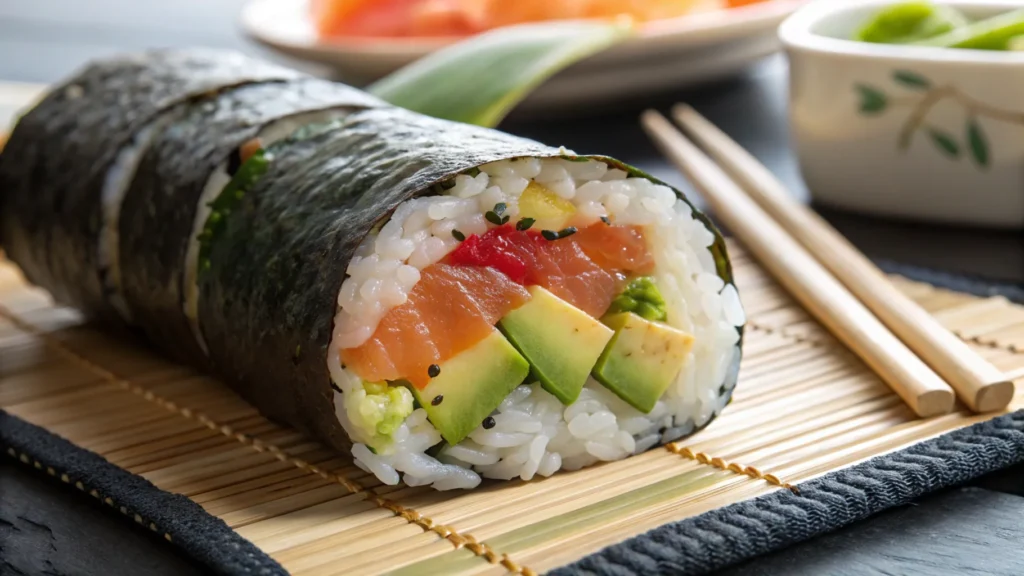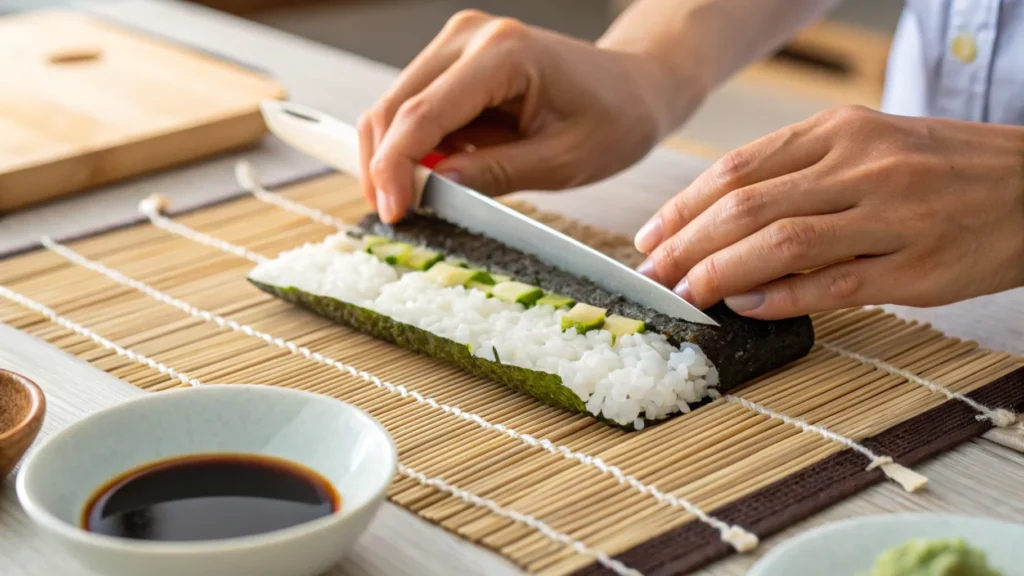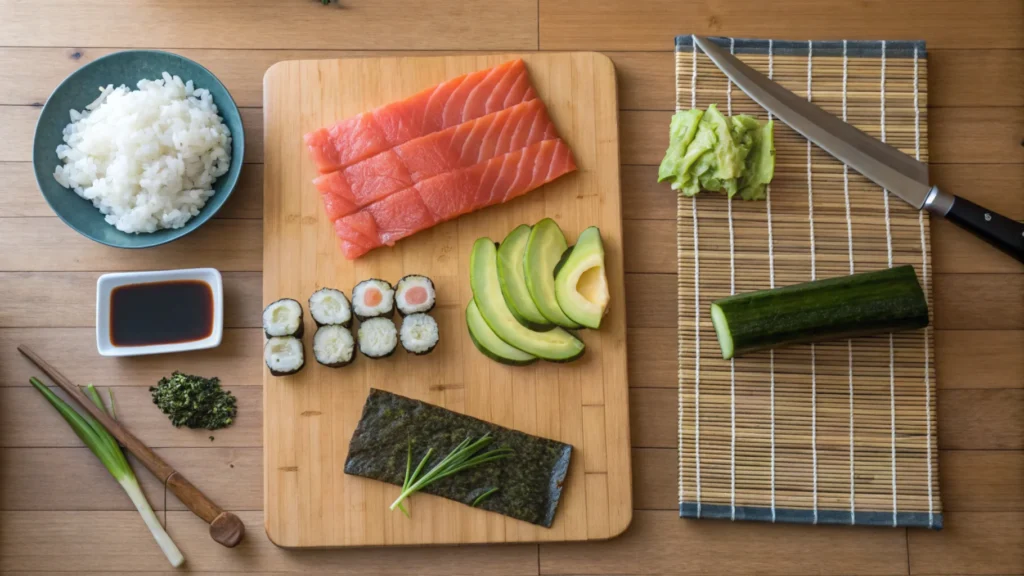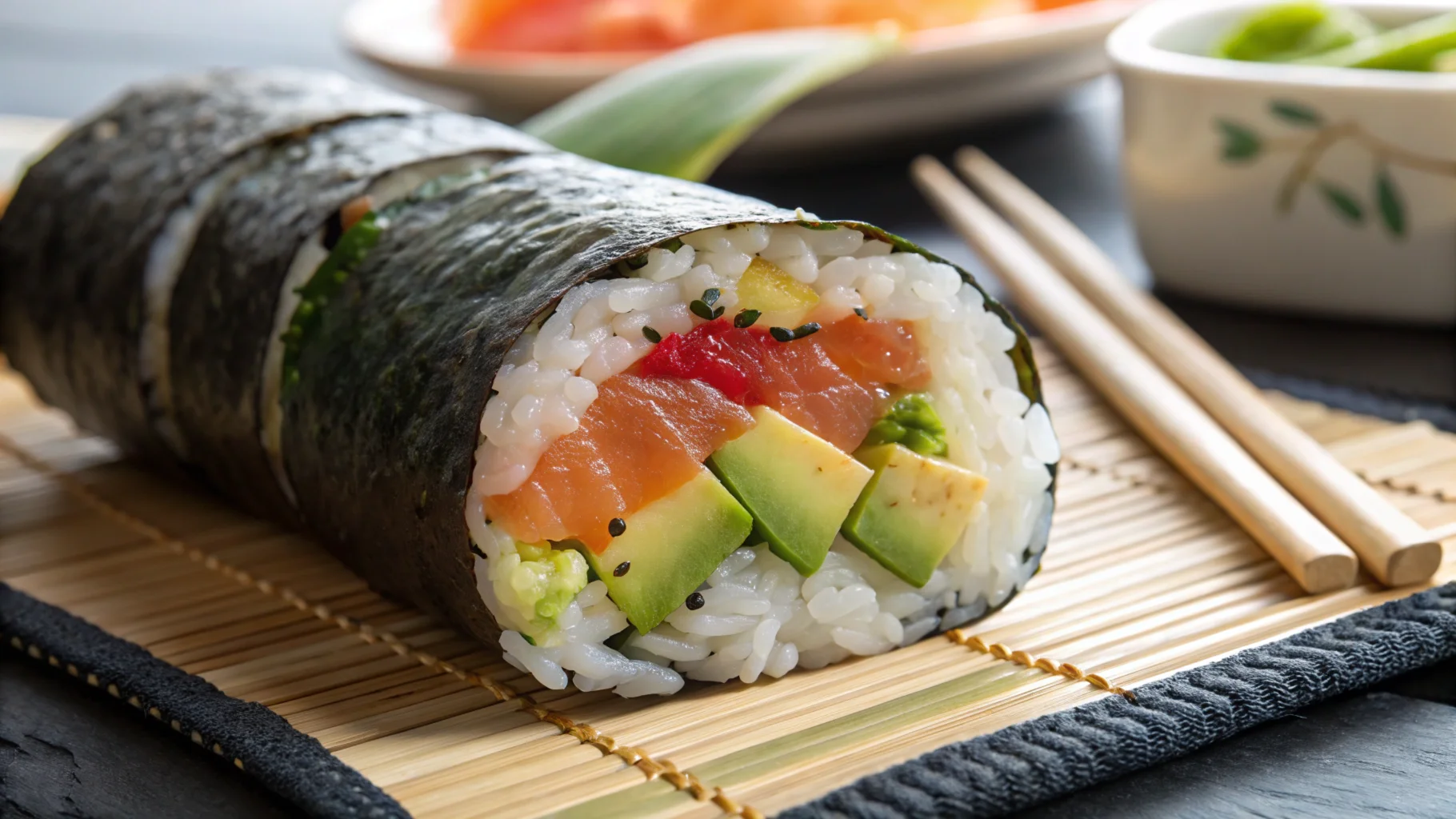Sushi and maki are two popular Japanese dishes that people often confuse because of their similarities and frequent pairing in restaurants. However, they have distinct characteristics in preparation, ingredients, and cultural significance.
This article will explore the differences between maki and sushi, their unique preparation methods, and their roles in Japanese cuisine. We’ll also touch on their health benefits and guide you on making them at home. For more details about maki, its types, and recipes, visit Maki Sushi: Types, Ingredients, Popular Recipes & Health Benefits.

Table of Contents
How Is Maki Different From Sushi?
While many people use the terms maki and sushi interchangeably, they actually refer to two distinct items within Japanese cuisine. Understanding how maki is different from sushi will give you a deeper appreciation for both.
Definition of Sushi
Sushi is a general term that refers to a dish primarily composed of vinegared rice, often paired with a variety of ingredients like raw fish, vegetables, or egg. The key element that defines sushi is the vinegared rice, also known as shari or sumeshi. Chefs serve sushi in different forms, such as nigiri, sashimi, or rolls.
Some of the most common types of sushi include:
- Nigiri: Hand-pressed rice topped with fish or other ingredients.
- Sashimi: Thinly sliced raw fish served without rice.
- Temaki: Hand-rolled sushi shaped into a cone with rice and fillings inside.
Although sushi may feature fish as a topping, it is not strictly defined by the inclusion of fish. Vegetarian sushi is also quite common.
Definition of Maki
On the other hand, this type of sushi is rolled into a cylindrical shape using a bamboo mat. It consists of vinegared rice, various fillings like fish, vegetables, or pickles, and chefs often wrap it in nori (seaweed). There are several variations, each differing in size and presentation.
Maki is typically divided into different types, including:
- Hosomaki: Small, tight rolls, typically made with a single filling.
- Uramaki: Inside-out rolls where rice is on the outside, often topped with sesame seeds or fish roe.
- Futomaki: Larger rolls, often filled with multiple ingredients.
Thus, maki is a subtype of sushi, but not all sushi is maki.

Key Differences Between Sushi and Maki
While sushi and maki share some common ingredients, the key differences lie in their preparation, ingredients, and presentation style.
Preparation Style
The primary difference between sushi and maki lies in their preparation. Sushi uses vinegared rice that chefs hand-press, roll, or serve raw (as in sashimi), requiring a balance of flavors.
- You season sushi rice with rice vinegar, sugar, and salt, then pair it with various ingredients like fish, vegetables, or egg.
- To prepare maki, you spread sushi rice on a sheet of nori, add fillings, and roll everything up with a bamboo mat. Then, you cut the roll into bite-sized pieces.
While sushi can be served in multiple forms, maki specifically refers to the rolled version. This difference in preparation methods is fundamental.
Ingredients
The ingredients used in sushi and maki are also a point of distinction.
- Sushi can include a variety of toppings or fillings, such as raw fish, cooked shrimp, vegetables, and even fruits like mango. The focus is on freshness, and the ingredients may vary based on regional preferences or availability.
- Maki, on the other hand, often uses a similar range of ingredients, but it specifically incorporates nori (seaweed) to wrap the rice and fillings together. The fillings can include fish, crab, cucumber, avocado, or pickled vegetables.
Although both sushi and maki share similar ingredients, their preparation and presentation differ.

Presentation
Presentation is another key difference between sushi and maki. Chefs present sushi as small, elegant bites meant to be eaten in one or two mouthfuls. They place the fish or toppings directly on top of the vinegared rice or serve them alongside.
- Nigiri sushi is presented simply, with a slice of fish or seafood delicately placed on top of a small ball of rice.
- Sashimi is often served on a bed of garnishes like shredded daikon radish and is presented without rice.
In contrast, chefs present maki as rolls cut into bite-sized pieces. They often arrange the rolls neatly on a plate, with the nori on the outside or the rice on the outside in the case of uramaki.
Types of Sushi Compared to Maki
There are many types of sushi, each offering a unique culinary experience. These dishes reflect the rich tradition of Japanese cuisine. While maki is a specific type of sushi, it’s important to note that sushi as a whole covers a broad range of dishes. Each type has its own distinct preparation and presentation style.
Nigiri Sushi: The Simple Elegance
Nigiri Sushi is one of the simplest yet most refined forms of sushi. It consists of a small mound of vinegared rice, traditionally hand-pressed, topped with a slice of fresh fish, seafood, or sometimes vegetables or eggs. Often, nigiri is accompanied by wasabi or pickled ginger, which add extra flavor and balance. This combination highlights the natural taste of the fish or topping, making it a favorite among sushi lovers. The focus is on the delicate pairing of rice and topping, allowing the freshness of the ingredients to shine.
Sashimi: The Pure Fish Experience
Sashimi is distinct from most other types of sushi, as it consists solely of thinly sliced raw fish or seafood served without rice. By removing the rice, the purity and quality of the fish become the focus of the dish. Typically, it is accompanied by soy sauce, wasabi, and sometimes garnished with shredded daikon radish. This presentation emphasizes freshness and allows the natural flavors of the sea to shine through, making it a refined choice for sushi enthusiasts.
Temaki: The Hand-Rolled Sushi
Temaki (known as hand rolls) is a more casual, fun way to enjoy sushi. Chefs make temaki as cone-shaped rolls by hand, wrapping nori around rice, fish, and vegetables. Unlike maki, which is sliced into bite-sized pieces, temaki is served whole and meant to be eaten immediately. This makes temaki a popular choice for informal gatherings or quick meals, offering a customizable and hands-on sushi experience.
Uramaki: The Inside-Out Roll
Uramaki, also known as inside-out rolls, is a type of maki where the rice is on the outside. It is typically covered with sesame seeds or fish roe. This variation was created to cater to Western tastes. Uramaki often includes fillings like avocado, cucumber, and fish. It offers a more colorful presentation and unique texture. The rice creates a soft exterior, while the nori is hidden inside.
Maki: A Versatile and Recognizable Style
Maki is one form of sushi, but it remains one of the most recognizable and beloved styles worldwide. Its versatility allows for a wide range of flavor combinations. You can enjoy traditional rolls with tuna or salmon, or try more inventive variations. These may include tempura, pickled vegetables, or even tropical fruits like mango.
The Popularity and Appeal of Sushi
The variety in sushi and maki offers a world of textures and tastes. That’s why these dishes are loved worldwide. Whether you prefer the simplicity of nigiri, the freshness of sashimi, or the playfulness of temaki, there’s a sushi style for every palate. Sushi encourages creativity and innovation. There’s always something new to try, even in familiar dishes.
Cultural Significance
Sushi and maki have deep cultural significance in Japan, and their preparation and consumption can vary depending on the occasion.
- People often associate sushi with celebrations like New Year’s and weddings, and they typically serve it in formal settings.
- Maki, especially in its rolled form, is a casual yet festive dish, ideal for gatherings, parties, and family meals.
Both dishes symbolize hospitality and reflect the Japanese concept of omotenashi—the art of ensuring guests feel genuinely cared for. Sushi represents fine dining and precision, while maki offers a more casual, versatile option, each playing a unique role in Japanese culinary tradition. For more on food safety and ideal preparation, learn about Can you eat salmon at 135 degrees?
Health Benefits
Sushi and maki offer a variety of health benefits, particularly because they often feature raw fish, vegetables, and minimal use of processed ingredients.
- Rich in Protein: The fish used in sushi and maki, such as tuna, salmon, and shrimp, are excellent sources of lean protein.
- Omega-3 Fatty Acids: Fish like salmon and mackerel are rich in omega-3 fatty acids, which are essential for heart health and brain function.
- Low in Calories: Sushi and maki can be low in calories, especially when made with lean fish, vegetables, and minimal sauces. This makes them a good option for those looking to maintain a healthy diet.
The seaweed in maki is rich in minerals and antioxidants, adding to the dish’s health benefits.
Making Sushi vs. Maki
If you want to make your own sushi or maki at home, it’s important to understand the steps involved.
Making Sushi
- Prepare the rice: Sushi rice must be rinsed to remove excess starch, cooked, and seasoned with vinegar, sugar, and salt.
- Prepare the toppings: Slice your fish or vegetables into thin, uniform pieces.
- Assemble the sushi: For nigiri, press small amounts of rice into compact balls and top them with fish or seafood. For sashimi, simply slice the fish and serve.
Making Maki
- Prepare the rice: Similar to sushi, you’ll need to prepare vinegared rice.
- Prepare the fillings: Choose your favorite fillings, such as cucumber, avocado, or fish.
- Roll the maki: Lay a sheet of nori on a bamboo mat, spread the rice evenly on top, and place your fillings in the center. Roll tightly and slice into bite-sized pieces.
The process for making maki requires a bit more technique, particularly with the rolling and cutting, but it can be very rewarding.
FAQs: How is Maki Different from Sushi?
What is the difference between maki and sushi?
The main difference between maki and sushi lies in their preparation and presentation. Sushi is a broad term for any dish that includes vinegared rice, paired with ingredients like raw fish, vegetables, eggs, or even fruits. It comes in different types, such as nigiri, sashimi, and various rolls (maki, temaki, etc.). In contrast, one type of rolled dish involves wrapping rice and fillings in nori (dried seaweed) and cutting them into small pieces. So, while all rolls are part of this cuisine, not all dishes belong to this category. The term refers to a broader range of preparations, while the rolled version is just one variation.
What is the difference between maki and Hosomaki?
The difference between maki and Hosomaki mainly lies in the size and the number of ingredients. Hosomaki is a smaller, tighter roll typically consisting of just one filling, such as cucumber, tuna, or avocado, wrapped in nori with rice on the inside. In contrast, this refers to a broader category of rolls that can include larger, thicker versions, such as Futomaki, which may contain multiple ingredients. Additionally, Uramaki, a type of roll, has rice on the outside. So, Hosomaki is a smaller and simpler version, with just one main ingredient.
What is the difference between maki and Tamaki sushi?
Tamaki (also called Temaki) is a hand roll, a cone-shaped sushi made by rolling nori around rice and fillings to form an open cone, typically eaten in one or two bites. Unlike maki, which is a cylindrical roll cut into bite-sized pieces, Tamaki remains whole and is meant to be consumed immediately. Maki is usually more formal, with neatly sliced pieces and often served in a more refined way. Tamaki is a more casual, easy-to-eat type of sushi, typically enjoyed in informal settings.
Is maki just sushi?
No, maki is not just a type of sushi, but rather a specific category of sushi. The term sushi encompasses a wide variety of dishes that use vinegared rice, such as nigiri (small rice balls topped with fish or seafood), sashimi (sliced raw fish without rice), and temaki (hand rolls). Maki, on the other hand, refers to rolls of sushi where chefs wrap rice and fillings in nori and cut them into small pieces. While all maki is a type of sushi, not all sushi is maki. Many forms of sushi are not rolled.
Conclusion: How is Maki Different from Sushi?
In conclusion, while both sushi and maki share common ingredients, they differ significantly in preparation, presentation, and cultural importance. Sushi is a broad category encompassing various forms like nigiri and sashimi, whereas maki specifically refers to the rolled version of sushi. Whether you enjoy the simplicity of nigiri or the creative versatility of maki, both offer unique and enjoyable experiences.
By understanding these differences, you can deepen your appreciation for Japanese cuisine and confidently explore its rich diversity. For a detailed comparison, visit What is the Difference Between Sushi and Maki? Explore the Key Differences.

